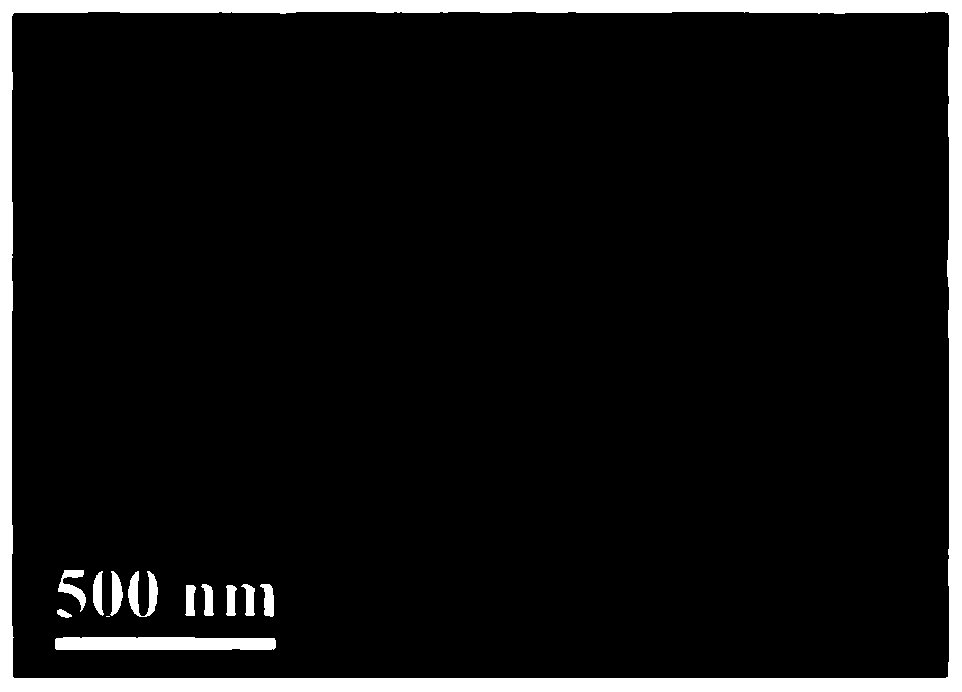Preparation method of gold and silver nanowire SERS sensor for detecting lung cancer marker miR-196a and sensor
A technology of silver nanowires and markers, applied in the field of materials, to achieve the effects of mild reaction conditions, simple methods, and mild synthesis conditions
- Summary
- Abstract
- Description
- Claims
- Application Information
AI Technical Summary
Problems solved by technology
Method used
Image
Examples
Embodiment 1
[0068] Example 1 Synthesis and characterization of silver nanowires and gold nanoparticles coupled gold-silver nanowires
[0069] 1) Add 10mL of ethylene glycol into a three-necked flask, condense and reflux at 160°C for 1 hour, then simultaneously add 5mL of 0.1M silver nitrate solution and 5mL of 0.2M polyvinylpyrrolidone dropwise at a rate of 0.3mL / min into the stirred In ethylene glycol, after the dropwise addition, the reaction lasted for 1 h. After the silver nanowires were cooled to room temperature (25° C. ± 2° C.), they were washed three times with acetone and ultrapure water respectively, and the silver nanowires were prepared before use.
[0070] 2) Add 50 μL of 24.3 mM chloroauric acid solution into a 50 mL beaker, and then add 20 mL of 0.15 mM sodium borohydride solution into the beaker under vigorous stirring (700 rpm). After reacting for 40 minutes at normal temperature, positively charged gold nanoparticles were synthesized.
[0071] 3) Add 20 mL of silver nan...
Embodiment 2
[0075] Preparation and characterization of embodiment 2 gold-silver nanowire substrate
[0076] 1) Prepare gold-silver nanowires as in Example 1.
[0077] 2) Cut the monocrystalline silicon wafer into small squares of 1em×1em. Then use acetone, absolute ethanol, and deionized water to ultrasonically clean 3 times, each cleaning time is 20 minutes, to ensure the cleanliness of the silicon wafer, and finally dry it with nitrogen gas for use. Place the clean silicon chip in a mixed solution of 98% concentrated sulfuric acid and 30% hydrogen peroxide at a volume ratio of 7:3, and place it in a water bath at 80°C for 1 hour to increase the -OH on the surface of the silicon chip, and finally rinse the silicon chip with ultrapure water. The sheet surface three times to eliminate the adsorption of impurity ions sulfate.
[0078] 3) Vertically immerse the activated silicon chip whose terminal group is a hydroxyl group in 0.1% 3-aminopropyltriethoxysilane-ethanol solution, and place i...
Embodiment 3
[0082] The optimized preparation of embodiment 3SERS sensor
[0083] 1) Prepare a gold-silver nanowire substrate as in Example 2.
[0084] 2) 50 μL of 10 μM DNA probe with hairpin structure (nucleotide sequence is 5′-SH-CCCGAAYCACAGTGAAACTACTAAGAGTAAGAGACCTTTAA-5FAM-3′, wherein: 3′-end modified Raman signal molecule 5-FAM; 5′-end modified thiol The group can be connected to the surface of the substrate through the Au-S bond, and the sequence can be specifically complementary to the nucleotide sequence of the target miRNA to be tested. The sequence table (SEQ ID No.1) is dropped onto the surface of the gold-silver nanowire substrate, Placed in an incubator at 25°C with 80% humidity for co-cultivation, and performed SERS tests every 15 minutes to screen the optimal assembly time of hpDNA (time for co-cultivation at 25°C with 80% humidity). Then, the hpDNA-functionalized gold-silver nanowire substrate was soaked in PBS buffer for 30 minutes to keep the shape of hpDNA stable; aft...
PUM
| Property | Measurement | Unit |
|---|---|---|
| Length | aaaaa | aaaaa |
| Diameter | aaaaa | aaaaa |
Abstract
Description
Claims
Application Information
 Login to View More
Login to View More - R&D
- Intellectual Property
- Life Sciences
- Materials
- Tech Scout
- Unparalleled Data Quality
- Higher Quality Content
- 60% Fewer Hallucinations
Browse by: Latest US Patents, China's latest patents, Technical Efficacy Thesaurus, Application Domain, Technology Topic, Popular Technical Reports.
© 2025 PatSnap. All rights reserved.Legal|Privacy policy|Modern Slavery Act Transparency Statement|Sitemap|About US| Contact US: help@patsnap.com



